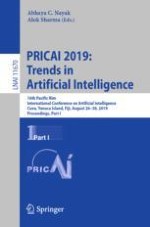2019 | Book
PRICAI 2019: Trends in Artificial Intelligence
16th Pacific Rim International Conference on Artificial Intelligence, Cuvu, Yanuca Island, Fiji, August 26–30, 2019, Proceedings, Part I
Editors: Abhaya C. Nayak, Alok Sharma
Publisher: Springer International Publishing
Book Series : Lecture Notes in Computer Science
